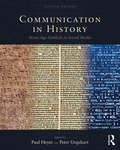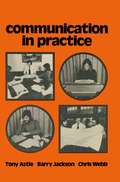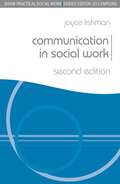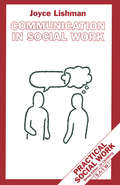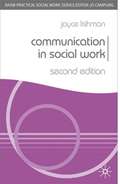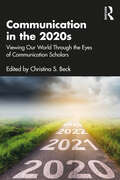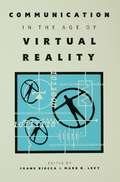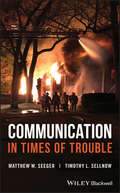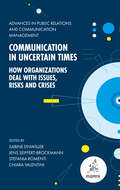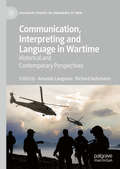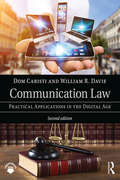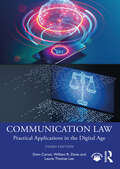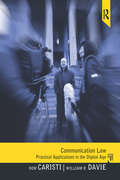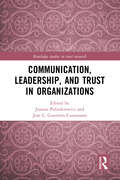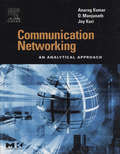- Table View
- List View
Communication in History: Stone Age Symbols to Social Media
by Peter Urquhart Paul HeyerNow in its 7th edition, Communication in History reveals how media has been influential in both maintaining social order and as powerful agents of change. Thirty-eight contributions from a wide range of voices offer instructors the opportunity to customize their courses while challenging students to build upon their own knowledge and skill sets. From stone-age symbols and early writing to the Internet and social media, readers are introduced to an expansive, intellectually enlivening study of the relationship between human history and communication media.
Communication in Organizational Environments: Functions, Determinants and Areas of Influence
by Anna Rogala Sylwester BialowasThis book showcases an interdisciplinary and comprehensive study of the issues related to communication in corporate environments. Including perspectives from psychology, sociology and management science, Communication in Organizational Environments analyzes original quantitative and qualitative research, and determines the functions, objectives and conditions of effective internal communication. In this book, the authors bridge the gap in the literature on the management of corporate internal communication, and provide a tool for measuring communication effectiveness. Useful as a guide for internal communication managers in various organizations, this book is also important reading for academics in corporate communication, public relations, corporate management and behaviour, and human resource management.
Communication in Social Work (Practical Social Work Series)
by Joyce LishmanEffective communication is a vital part of the social worker's job. This welcome new edition of a classic text provides students and practitioners with essential advice and guidance about communicating and interacting in a range of social work settings. Based on the author's extensive personal and teaching experience, the text offers a succint introduction to a variety of communication techniques, including symbolic, non-verbal, verbal, written and electronic forms of communication. Importantly, it discusses the perspectives of service users and explores their experiences and interpretations of how a social worker looks, acts and speaks, thus giving a real insight into the implicit messages being conveyed. New to this edition are Putting it into Practice activities and further reading suggestions, designed to support learning and understanding and to enable readers to reflect critically for practice. Written in an appealing narrative style that cannot fail to draw the reader in, Communication in Social Work is an engaging and comprehensive book suitable both for social work and social care students and for newly qualified practitioners wanting to refresh their thinking and skills.
Communication in Social Work (Practical Social Work Series)
by Joyce LishmanUsing knowledge of communication skills from different sources (studies of chat perception, social psychology, evaluation research and practice theory), this volume introduces and examines the non-verbal, symbolic, verbal and written communication skills required for social work practice in all settings. It then applies this basic knowledge and understanding to different purposes of social work; relationship building and maintaining, listening, giving information and advice, making a contract and intervention to help clients problem-solve or change attitudes or behaviour.
Communication In Social Work (PDF)
by Joyce Lishman Jo CamplingThis timely new edition identifies the important skills integral to effective communication in social work. Based on the premise that good communication skills are essential to good social work, the second edition offers an extended account of its subject that pays more attention to the diverse contexts of social work and the range of clients and users with whom practitioners come in contact.
Communication in the 2020s: Viewing Our World Through the Eyes of Communication Scholars
by Christina S. BeckThis book provides an inside look at the discipline of Communication. In this collection of chapters, top scholars from a wide range of subfields discuss how they have experienced and how they study the crucial issues of our time. The 2020s opened with a series of events with massive implications for the ways we communicate, from the COVID-19 pandemic, a summer of protests for social justice, and climate change-related natural disasters, to one of the most contentious presidential elections in modern U.S. history. The chapters in this book provide snapshots of many of these issues as seen through the eyes of specialists in the major subfields of Communication, including interpersonal, organizational, strategic, environmental, religious, social justice, risk, sport, health, family, instructional, and political communication. Written in an informal style that blends personal narrative with accessible explanation of basic concepts, the book is ideal for introducing students to the range and practical applications of Communication discipline. This book comprises a valuable companion text for Introduction to Communication courses as well as a primary resource for Capstone and Introduction to Graduate Studies courses. Further, this collection provides meaningful insights for Communication scholars as we look ahead to the remainder of the 2020s and beyond.
Communication in the 2020s: Viewing Our World Through the Eyes of Communication Scholars
by Christina S. BeckThis book provides an inside look at the discipline of Communication. In this collection of chapters, top scholars from a wide range of subfields discuss how they have experienced and how they study the crucial issues of our time. The 2020s opened with a series of events with massive implications for the ways we communicate, from the COVID-19 pandemic, a summer of protests for social justice, and climate change-related natural disasters, to one of the most contentious presidential elections in modern U.S. history. The chapters in this book provide snapshots of many of these issues as seen through the eyes of specialists in the major subfields of Communication, including interpersonal, organizational, strategic, environmental, religious, social justice, risk, sport, health, family, instructional, and political communication. Written in an informal style that blends personal narrative with accessible explanation of basic concepts, the book is ideal for introducing students to the range and practical applications of Communication discipline. This book comprises a valuable companion text for Introduction to Communication courses as well as a primary resource for Capstone and Introduction to Graduate Studies courses. Further, this collection provides meaningful insights for Communication scholars as we look ahead to the remainder of the 2020s and beyond.
Communication in the Age of Virtual Reality (Routledge Communication Series)
by Frank Biocca Mark R. LevyThis volume addresses virtual reality (VR) -- a tantalizing communication medium whose essence challenges our most deeply held notions of what communication is or can be. The editors have gathered an expert team of engineers, social scientists, and cultural theorists for the first extensive treatment of human communication in this exciting medium. The first part introduces the reader to VR's state-of-the-art as well as future trends. In the next section, leading research scientists discuss how knowledge of communication can be used to build more effective and exciting communication applications of virtual reality. Looking ahead, the authors explore pioneering approaches to VR narratives, interpersonal communication, the use of 3D sound, and the building of VR entertainment complexes. In the final section, the authors zoom out to view the big picture -- the psychological, social, and cultural implications of virtual reality. Thought-provoking discussions consider important communication issues such as: * How will virtual reality influence perception of reality? * What are the legal issues defining communication in virtual reality? * What kind of cultural trends will this technology encourage?
Communication in the Age of Virtual Reality (Routledge Communication Series)
by Frank Biocca Mark R. LevyThis volume addresses virtual reality (VR) -- a tantalizing communication medium whose essence challenges our most deeply held notions of what communication is or can be. The editors have gathered an expert team of engineers, social scientists, and cultural theorists for the first extensive treatment of human communication in this exciting medium. The first part introduces the reader to VR's state-of-the-art as well as future trends. In the next section, leading research scientists discuss how knowledge of communication can be used to build more effective and exciting communication applications of virtual reality. Looking ahead, the authors explore pioneering approaches to VR narratives, interpersonal communication, the use of 3D sound, and the building of VR entertainment complexes. In the final section, the authors zoom out to view the big picture -- the psychological, social, and cultural implications of virtual reality. Thought-provoking discussions consider important communication issues such as: * How will virtual reality influence perception of reality? * What are the legal issues defining communication in virtual reality? * What kind of cultural trends will this technology encourage?
Communication in Times of Trouble
by Matthew W. Seeger Timothy L. SellnowPresents the best practices of crisis communication and emergency risk communication This book covers crisis communication strategies and focuses on practical applications for effective management. It includes an extensive discussion of best practices in pre-crisis, crisis and post crisis stages. The book pays special attention to the needs of meeting the needs of diverse audiences and communicating in a responsive and responsible way. The principles are appropriate for many kinds of events including earthquakes, tornadoes, hurricanes, tsunamis, epidemics, and pandemics as well as industrial accidents, toxic spills, transportation disasters, fires and intentional events. In the first chapter, Communication in Times of Trouble introduces the concept of best practices and establishes their relevance for crisis communication and emergency risk communication. A chapter is dedicated to each of the ten best practices. In each chapter, the best practice is described, examples of successful and unsuccessful application of the best practice in both organizational crises and natural disasters/emergencies are provided, advice for practical application is given, and a summary is provided. The concluding chapter details the challenges and opportunities for developing and implementing a response strategy that includes the best practices as a whole. Focuses on application and explanation in crisis communication to benefit those with backgrounds in emergency management, risk management, political science, disaster sociology, and public health Covers natural, large-scale emergencies such as earthquakes, tornadoes, hurricanes, tsunamis, epidemics, and pandemics, which aren’t generally detailed in existing crisis communication texts Presents 10 best practices for dealing with emergencies: Process Approach; Pre-Event Planning; Partnerships; Public Concern; Honesty; Collaborate; Media access; Compassion; Uncertainty; Empowerment Communication in Times of Trouble will be of great interest to undergraduate students and practitioners in communication, public relations, public affairs, public information, public health, and emergency management.
Communication in Times of Trouble
by Matthew W. Seeger Timothy L. SellnowPresents the best practices of crisis communication and emergency risk communication This book covers crisis communication strategies and focuses on practical applications for effective management. It includes an extensive discussion of best practices in pre-crisis, crisis and post crisis stages. The book pays special attention to the needs of meeting the needs of diverse audiences and communicating in a responsive and responsible way. The principles are appropriate for many kinds of events including earthquakes, tornadoes, hurricanes, tsunamis, epidemics, and pandemics as well as industrial accidents, toxic spills, transportation disasters, fires and intentional events. In the first chapter, Communication in Times of Trouble introduces the concept of best practices and establishes their relevance for crisis communication and emergency risk communication. A chapter is dedicated to each of the ten best practices. In each chapter, the best practice is described, examples of successful and unsuccessful application of the best practice in both organizational crises and natural disasters/emergencies are provided, advice for practical application is given, and a summary is provided. The concluding chapter details the challenges and opportunities for developing and implementing a response strategy that includes the best practices as a whole. Focuses on application and explanation in crisis communication to benefit those with backgrounds in emergency management, risk management, political science, disaster sociology, and public health Covers natural, large-scale emergencies such as earthquakes, tornadoes, hurricanes, tsunamis, epidemics, and pandemics, which aren’t generally detailed in existing crisis communication texts Presents 10 best practices for dealing with emergencies: Process Approach; Pre-Event Planning; Partnerships; Public Concern; Honesty; Collaborate; Media access; Compassion; Uncertainty; Empowerment Communication in Times of Trouble will be of great interest to undergraduate students and practitioners in communication, public relations, public affairs, public information, public health, and emergency management.
Communication in Uncertain Times: How Organizations Deal with Issues, Risks and Crises (Advances in Public Relations and Communication Management #7)
by SABINE EINWILLER, JENS SEIFFERT-BROCKMANN, STEFANIA ROMENTI AND CHIARA VALENTINITechnological developments and globalization have not only propelled societal progress, but they have also ushered in significant challenges and risks that continually demand responses and adaptability from today’s dynamic and complex societies. In this context, organizations find themselves grappling with the need to navigate and manage these challenges effectively. For public relations scholars and practitioners, this reality poses crucial questions concerning communication strategies and their impact in today’s risk societies. Communication in Uncertain Times explores how different organizations, from private to governmental and non-profit, deal with issues, risks, and crisis situations through communication. Questions include how to address risks and issues to decrease uncertainty, how to negotiate conflicts, and what types of roles professionals and non-professional communicators assume in times of risk, uncertainty, and crises. The chapters comprise selected contributions to the 2022 Annual Congress of the European Public Relations Education and Research Association (EUPRERA) hosted in Vienna, Austria, by the University of Vienna and the Vienna University of Economics and Business. Advances in Public Relations and Communication Management (APCRM) is a publication of the European Public Relations Education and Research Association (EUPRERA). Each volume includes contributions from EUPRERA’s annual congress and follow the theme of each event.
Communication in Uncertain Times: How Organizations Deal with Issues, Risks and Crises (Advances in Public Relations and Communication Management #7)
by Chiara Valentini Stefania Romenti Jens Seiffert-Brockmann Sabine EinwillerTechnological developments and globalization have not only propelled societal progress, but they have also ushered in significant challenges and risks that continually demand responses and adaptability from today’s dynamic and complex societies. In this context, organizations find themselves grappling with the need to navigate and manage these challenges effectively. For public relations scholars and practitioners, this reality poses crucial questions concerning communication strategies and their impact in today’s risk societies. Communication in Uncertain Times explores how different organizations, from private to governmental and non-profit, deal with issues, risks, and crisis situations through communication. Questions include how to address risks and issues to decrease uncertainty, how to negotiate conflicts, and what types of roles professionals and non-professional communicators assume in times of risk, uncertainty, and crises. The chapters comprise selected contributions to the 2022 Annual Congress of the European Public Relations Education and Research Association (EUPRERA) hosted in Vienna, Austria, by the University of Vienna and the Vienna University of Economics and Business. Advances in Public Relations and Communication Management (APCRM) is a publication of the European Public Relations Education and Research Association (EUPRERA). Each volume includes contributions from EUPRERA’s annual congress and follow the theme of each event.
Communication, Interpreting and Language in Wartime: Historical and Contemporary Perspectives (Palgrave Studies in Languages at War)
by Amanda Laugesen Richard GehrmannThis edited book provides a multi-disciplinary approach to the topics of translation and cross-cultural communication in times of war and conflict. It examines the historical and contemporary experiences of interpreters in war and in war crimes trials, as well as considering policy issues in communication difficulties in war-related contexts. The range of perspectives incorporated in this volume will appeal to scholars, practitioners and policy-makers, particularly in the fields of translating and interpreting, conflict and war studies, and military history.
Communication Law: Practical Applications in the Digital Age
by Dom Caristi William R DavieNow in its second edition, Communication Law: Practical Applications in the Digital Age is an engaging and accessible text that brings a fresh approach to the fundamentals of mass media law. Designed for students of communication that are new to law, this volume presents its readers with key principles and emphasizes the impact of timely, landmark cases on today’s media world, providing an applied learning experience. This new edition offers a brand new chapter on digital media law, a wealth of new case studies, and expanded discussions of current political, social, and cultural issues.
Communication Law: Practical Applications in the Digital Age
by Dom Caristi William R DavieNow in its second edition, Communication Law: Practical Applications in the Digital Age is an engaging and accessible text that brings a fresh approach to the fundamentals of mass media law. Designed for students of communication that are new to law, this volume presents its readers with key principles and emphasizes the impact of timely, landmark cases on today’s media world, providing an applied learning experience. This new edition offers a brand new chapter on digital media law, a wealth of new case studies, and expanded discussions of current political, social, and cultural issues.
Communication Law: Practical Applications in the Digital Age
by Dom Caristi William R Davie Laurie Thomas LeeThis fully revised third edition brings a fresh approach to the fundamentals of mass media and communication law in a presentation that undergraduate students find engaging and accessible. Designed for students of communication that are new to law, this volume presents key principles and emphasizes the impact of timely, landmark cases on today’s media world, providing an applied learning experience. This new edition offers expanded coverage of digital media law and social media, a wealth of new case studies, expanded discussions of current political, social, and cultural issues, and new features focused on ethical considerations and on international comparative law. Communication Law serves as a core textbook for undergraduate courses in communication and mass media law. Online resources for instructors, including an Instructor’s Manual, Test Bank, and PowerPoint slides, are available at: www.routledge.com/9780367546694
Communication Law: Practical Applications in the Digital Age
by Dom Caristi William R Davie Laurie Thomas LeeThis fully revised third edition brings a fresh approach to the fundamentals of mass media and communication law in a presentation that undergraduate students find engaging and accessible. Designed for students of communication that are new to law, this volume presents key principles and emphasizes the impact of timely, landmark cases on today’s media world, providing an applied learning experience. This new edition offers expanded coverage of digital media law and social media, a wealth of new case studies, expanded discussions of current political, social, and cultural issues, and new features focused on ethical considerations and on international comparative law. Communication Law serves as a core textbook for undergraduate courses in communication and mass media law. Online resources for instructors, including an Instructor’s Manual, Test Bank, and PowerPoint slides, are available at: www.routledge.com/9780367546694
Communication Law
by Dominic G Caristi William R Davie Michael CavanaughDebuting in its first edition, Communication Law is an engaging and accessible text that brings a fresh approach to the fundamentals of mass media law. Unique in its approach and its visually attractive design, this text differentiates itself from other current texts on the market while presenting students with key principles and landmark cases that establish and define communication law and regulation, providing a hands-on learning experience.
Communication Law
by Dominic G Caristi William R Davie Michael CavanaughDebuting in its first edition, Communication Law is an engaging and accessible text that brings a fresh approach to the fundamentals of mass media law. Unique in its approach and its visually attractive design, this text differentiates itself from other current texts on the market while presenting students with key principles and landmark cases that establish and define communication law and regulation, providing a hands-on learning experience.
Communication, Leadership and Trust in Organizations (Routledge Studies in Trust Research)
by Joanna Paliszkiewicz Cusumano, Jose L. GuerreroTrust in communication and leadership is the key to success in business. This book presents and discusses the main issues and challenges posed by communication, leadership, and trust. The first part of the book describes the communication and trust issues, the second part presents the role of trust in leadership, and the third part describes different examples of implementing trust to organizations. Readers will gain from this book theoretical and practical knowledge of communication, leadership, and trust; empirically validated practice regarding trust and its related concepts; and a novel approach for addressing this topic. This book can be used as a toolbox to improve understanding and opportunities related to building trust in organizations and will be especially valuable for students and researchers in the fields of leadership, organizational communication, business ethics, and trust research.
Communication, Leadership and Trust in Organizations (Routledge Studies in Trust Research)
by Joanna Paliszkiewicz José L. Guerrero CusumanoTrust in communication and leadership is the key to success in business. This book presents and discusses the main issues and challenges posed by communication, leadership, and trust. The first part of the book describes the communication and trust issues, the second part presents the role of trust in leadership, and the third part describes different examples of implementing trust to organizations. Readers will gain from this book theoretical and practical knowledge of communication, leadership, and trust; empirically validated practice regarding trust and its related concepts; and a novel approach for addressing this topic. This book can be used as a toolbox to improve understanding and opportunities related to building trust in organizations and will be especially valuable for students and researchers in the fields of leadership, organizational communication, business ethics, and trust research.
The Communication Manifesto
by Silvio WaisbordContemporary societies demand clear-minded, evidence-based ideas to address complex social issues. Communication scholarship has a rich trove of knowledge and experiences to help address such problems. In this passionately argued manifesto, Silvio Waisbord examines public scholarship in communication studies and its potential for contributing to the common good. He discusses the various ways scholars seek to serve the public as practitioners, experts, advocates, activists and critics, and underscores their significant contribution which has not, to date, been properly supported or recognized. Only by tackling academic institutional politics, he argues, will it be possible to strengthen public scholarship as central to the mission of communication studies. The Communication Manifesto is a roadmap to action and will inspire communication scholars and students to be public citizens, thereby connecting their work and expertise to the causes of solidarity, humanity and social justice.
Communication Networking: An Analytical Approach (ISSN)
by Anurag Kumar D. Manjunath Joy KuriCommunication Networking is a comprehensive, effectively organized introduction to the realities of communication network engineering. Written for both the workplace and the classroom, this book lays the foundation and provides the answers required for building an efficient, state-of-the-art network—one that can expand to meet growing demand and evolve to capitalize on coming technological advances. It focuses on the three building blocks out of which a communication network is constructed: multiplexing, switching, and routing. The discussions are based on the viewpoint that communication networking is about efficient resource sharing. The progression is natural: the book begins with individual physical links and proceeds to their combination in a network. The approach is analytical: discussion is driven by mathematical analyses of and solutions to specific engineering problems. Fundamental concepts are explained in detail and design issues are placed in context through real world examples from current technologies. The text offers in-depth coverage of many current topics, including network calculus with deterministically-constrained traffic; congestion control for elastic traffic; packet switch queuing; switching architectures; virtual path routing; and routing for quality of service. It also includes more than 200 hands-on exercises and class-tested problems, dozens of schematic figures, a review of key mathematical concepts, and a glossary. This book will be of interest to networking professionals whose work is primarily architecture definition and implementation, i.e., network engineers and designers at telecom companies, industrial research labs, etc. It will also appeal to final year undergrad and first year graduate students in EE, CE, and CS programs.Systematically uses mathematical models and analyses to drive the development of a practical understanding of core network engineering problems.Provides in-depth coverage of many current topics, including network calculus with deterministically-constrained traffic, congestion control for elastic traffic, packet switch queuing, switching architectures, virtual path routing, and routing for quality of service.Includes over 200 hands-on exercises and class-tested problems, dozens of schematic figures, a review of key mathematical concepts, and a glossary.
